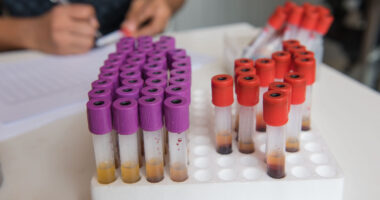MRI parameter may be new FAP biomarker, study suggests
Fat in tissue surrounding peripheral nerves seen higher in FAP patients

A higher proportion of fat in the tissue that surrounds peripheral nerves, as assessed with a noninvasive MRI scan, may be a new diagnostic biomarker of familial amyloid polyneuropathy (FAP), a study showed.
This measure, called intraepineurial fat fraction (ieFF), may indicate nerve fiber replacement by fat tissue and subsequent damage. It was found to effectively distinguish FAP patients from healthy controls and to be significantly associated with clinical scores and nerve electrical activity.
“The present results illustrate the interest of a multimodal qMRI [quantitative MRI] imaging analysis of the whole lower limb in patients with [FAP] while highlighting ieFF as a new sensitive biomarker,” the researchers wrote. Quantitative MRI measures various non-visual parameters of the chemical structure and makeup of tissues.
The study, “Intraepineurial Fat Fraction: A Novel MR Neurography-Based Biomarker in Transthyretin Amyloidosis Polyneuropathy,” was published in the European Journal of Neurology.
FAP is a type of hereditary transthyretin amyloidosis, or ATTRv, a group of conditions caused by mutations in the TTR gene that lead to the formation of toxic clumps, called amyloid fibrils, of the transthyretin protein.
Measuring ieFF
In people with FAP, amyloid fibrils tend to accumulate in peripheral nerves — those outside the brain and spinal cord — leading to nerve damage (polyneuropathy) and subsequent FAP symptoms.
FAP diagnosis usually relies on genetic testing, tissue analysis to detect the presence of amyloid fibrils, and nerve function tests.
Researchers at Aix-Marseille University in France analyzed whether ieFF, measured through quantitative MRI, could be used as a FAP biomarker.
The study looked at 53 people carrying TTR mutations: 22 who were not yet showing symptoms (asymptomatic carriers) and 31 who were experiencing symptoms (symptomatic patients). More than half (58%) carried Val30Met, the most common FAP-causing mutation.
Data from the 53 mutation carriers were compared with those of 24 healthy controls. Symptomatic patients were significantly older (age 56) than asymptomatic carriers (46) and controls (45).
Results showed that ieFF values were significantly higher in the FAP group than in healthy controls, both in the tibial nerve (13.7% vs. 9.74%) and the sciatic nerve (32.4% vs. 22.3%). Similar, significant differences were seen between asymptomatic carriers and controls.
The tibial nerve is the major nerve in the lower leg that provides movement and sensation to the leg and foot. The sciatic nerve originates in the lower back, and extends down the back of the legs.
Further statistical analyses showed that a higher ieFF of the tibial or sciatic nerves, indicating more fat content was significantly associated with worse scores on several clinical severity measures, including the Polyneuropathy Disability Score (PND), Overall Neuropathy Limitations Scale (ONLS), and Rasch-Built Overall Disability Scale (RODS).
PND analyzes FAP patients’ functional disability, ONLS assesses patients’ functional limitations due to peripheral nerve damage, and RODS evaluates how polyneuropathy affects the patient’s daily and social activities.
Elevated ieFF values were significantly associated with lower scores on parameters of nerve conduction tests, which measure the strength and speed at which a nerve can transmit an electrical signal to other areas of the body. This meant that a higher fat content around nerves was tied to worse nerve conduction.
The team also looked at more conventional qMRI parameters related to nerve volume and structural integrity (including the magnetization transfer ratio, or MTR).
Particularly, symptomatic carriers had a higher volume of tibial and sciatic nerves than asymptomatic carriers and healthy participants. A higher nerve volume has been associated with amyloid fibrils buildup in nerves.
Symptomatic FAP patients also had signs of nerve damage in tibial nerves, including a significant lower MTR, compared with asymptomatic carriers and healthy controls.
There were no significant differences in terms of conventional parameters between asymptomatic carriers and healthy people.
Overall, conventional qMRI parameters were found to be less associated with clinical and nerve conduction parameters than ieFF, suggesting the latter “could be the most interesting qMRI parameter when assessing disease severity,” the researchers wrote. “Moreover, ieFF was the only parameter that was statistically different between [asymptomatic carriers] and [healthy controls].”
“Using this set of qMRI parameters, the [asymptomatic carriers] would be characterized by an intermediate pattern with an increased ieFF, while MTR and nerve volume remain in the normal range,” the team wrote.
Previous studies have suggested that amyloids fibrils may also contain fat molecules, which may explain the increase in ieFF around nerve fibers. The team hypothesized that the observed increase in nerve fat fraction may represent the fatty droplets found in amyloid fibrils surrounding nerves and the onset of nerve fiber loss accompanied by replacement of surrounding tissue by fat.






